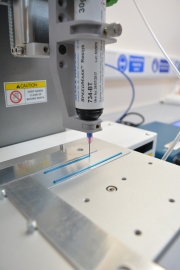 Save time and money by considering production from the offset
Save time and money by considering production from the offset
When a design engineer requires an adhesive to bond one substrate to another, they can save time, money and effort by designing with production in mind. Kevin Cook, technical manager of adhesives specialist Intertronics, offers some things to think about.
During the design process, it is common to produce a prototype 3D model which will be tweaked, adjusted and improved until it matches form, fit and function requirements. However, if the designer hasn’t considered how the prototype will be scaled up into a saleable product, they could run into problems. The designer could be forced to adapt their product, or the environment the product is going into, for it to be functional.
 Materials
Materials
The designer should use the same substrate in the prototyping and testing stages as will be used in production to ensure consistency. Considering adhesion from the outset can help the designer to make an appropriate substrate choice. Certain adhesives are better suited to plastic or metal, and an appropriate substrate choice can bring the best out of an adhesive. Consider this example. A designer is planning to bond pieces of acrylonitrile butadiene styrene (ABS) to each other with one adhesive, but later changes the substrate to polyethylene. The new material will require a different adhesive and will have different dispensing requirements, kickstarting a domino effect. The original production process can no longer be used and the designer must go back to the drawing board or use their second choice of material.
Consider how the joint will provide the right support for the structure, particularly if it is a structural component. An exposed or unsupported joint may be weak, regardless of adhesive choice.
The designer should also consider where the product will be manufactured and used. For example, a cyanoacrylate adhesive would not cure successfully in a cleanroom, as the humidity in the air would be too low. If the product will be subject to a harsh environment such as salt water or temperature fluctuations, the designer must ensure the adhesive and substrate can withstand the conditions.
The adhesive must also be appropriate for the application. For example, some room temperature vulcanising (RTV) silicones have a corrosive by-product, which makes them unsuitable for use in the electronics industry.
Method
Bond line design is a critical consideration during the design process. To make dispensing as easy as possible, the designer must ensure the bond line is not obscured behind another feature. There are several common dispensing techniques, from simple time pressure dispensing to volumetric dispensing. Consider whether adhesive dispensing will be a manual, semi-automated or automated process.
If the bond line is difficult to access, it can require a six-axis robot to dispense the adhesive, greatly increasing project costs. Alternatively, the adhesive could be applied by hand, increasing labour costs and the risk of error.
To use a UV curing adhesive, the entire bond line must be visible. If it is not, the designer has ruled out a popular adhesive choice early on or must redesign the product so that the bond line is visible.
Single part adhesives are easier to dispense and handle than mixed. By opting for a single part, UV curing adhesive, the part can be cured rapidly — an easy process to automate. Two-part materials begin to gel and change in viscosity as soon as they are mixed. This means that simple time pressure dispensing techniques, which require the adhesive to be in a constant state, are unsuitable. The designer would require a different technique, such as volumetric dispensing, for production to be successful.
 Return on investment
Return on investment
Return on investment is an important consideration when thinking about what the budget will support when scaling up to production. This is not as simple as considering upfront cost; time, labour requirements and materials supply should be factored in too. Semi-automated or fully-automated solutions offer good return on investment as they can reduce operator variability and strain, reduce scrap and improve consistency. An adhesive which is cheaper to purchase, but more difficult to handle, takes up more labour time or requires investment in more costly dispensing techniques.
One of the biggest production considerations for a business when scaling up is time. The curing time of adhesives can vary from seconds to days. If work in progress (WIP) is an important factor during production, the manufacturer must take the curing time into account to ensure that WIP is not sat on a bench, unable to move forward, because of the curing process.
Intertronics works with designers at every stage from design to production to help you bring your product to market efficiently and without costly errors. To speak to an adhesives specialist, get in touch on 01865 842842.
Contact:
Intertronics
Station Field Industrial Estate, Banbury Road, Kidlington, Oxfordshire, OX5 1JD
+44 (0) 1865 842842
https://www.intertronics.co.uk/
